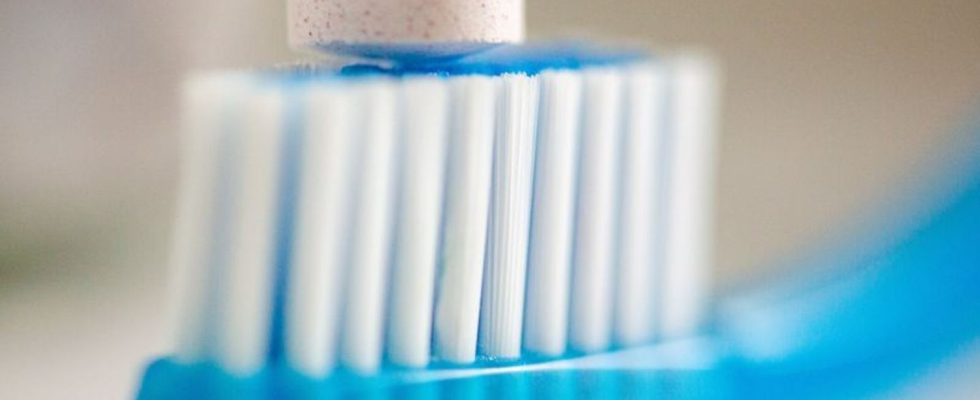No toothpaste in the bathroom? This is probably hard to imagine for many people. There are also special tabs for brushing your teeth. Does this have any health benefits, as is sometimes claimed?
Put toothpaste on the brush, water over it and put it in your mouth. This routine in the bathroom of millions of people is being called into question by alternative products: so-called toothbrush tabs. They look like tablets, but are not intended to be swallowed, but rather have to be chewed briefly. Spit creates a creamy mixture in your mouth, which you then use to brush your teeth. Such tabs were initially often found in organic and unpackaged stores, but now also in some drugstores and supermarkets. There are also providers on the Internet.
What arguments are used to advertise toothbrush tabs?
The tabs are packaged in bags or reusable containers, for example. These can be purchasing incentives for people who want to avoid plastic packaging or at least use less of it. Tabs are also considered practical when traveling because nothing can leak and you can pack smaller quantities.
Some companies also present their tabs as beneficial to health – or conventional toothpaste as potentially unhealthy. For example, they advertise that they have omitted certain substances. And some people criticize fluoride, which is the substance in many toothpastes that is important for preventing tooth decay. Other ingredients are sometimes described as a problem – for example those that are responsible for how toothpaste foams, looks and tastes.
Until recently, there was a demand for as many different toothpaste effects as possible with more and more active ingredients, but the trend in the discussion about sustainability and climate protection has completely changed, says the head of the Department of Dentistry, Oral and Maxillofacial Medicine at the University of Witten /Herdecke, Stefan Zimmer: “The products should now be as pure as possible.” So have as few ingredients as possible.
Are toothpaste ingredients unhealthy?
When asked, the Federal Institute for Risk Assessment (BfR) stated that it had “no evidence” that toothpaste ingredients were absorbed in toxicologically questionable quantities. In general, every ingredient in a cosmetic product as well as the finished product must undergo a legally required safety assessment before it is placed on the market. “The manufacturer/distributor is liable for the health safety of the products,” explains the BfR.
False information and absurd claims have been circulating for a long time, particularly regarding fluoride. “I have been a dentist for 35 years and nothing has changed in that time because some patient groups have reservations about fluoride,” says Zimmer. Not only he, but also other experts emphasize that the trace element is not harmful – at least not in the low doses contained in toothpaste.
The magazine “Ökotest” reported in the summer that an adult would have to swallow two to three tubes of toothpaste for acute poisoning with symptoms; one would only die if they ate the contents of 33 to 67 tubes. Fluoride should not be confused with the poisonous gas fluorine.
According to the Federal Dental Association, the spread of toothpaste containing fluoride has led to a very significant reduction in tooth decay among children and young people. It helps to make the teeth more resilient. “The main effect of brushing your teeth is the fluoride effect,” says Zimmer. It is a misconception that brushing alone protects against tooth decay. However, mechanical cleaning is not superfluous: it is important against periodontitis, a bacterial inflammation of the periodontium, and supports the effectiveness of fluoride against tooth decay.
Tabs or toothpaste? A question of the amount of fluoride
According to the Federal Dental Association, it doesn’t matter whether you brush your teeth with toothpaste or a tab, as long as there is enough of this substance in it: “Toothbrush tablets can be an alternative to classic toothpaste if the content is right, i.e. they must contain enough fluoride.” But how much is enough? This is where things get more complicated.
Tabs and toothpaste can contain the same concentration of fluoride, usually 1450 ppm, according to the information on the packaging. But according to Zimmer, that doesn’t mean that a lot of it ends up in your mouth. He gives a calculation example: For one manufacturer, a tab only weighs around 0.3 grams. Of toothpaste, on the other hand, you use 1 to 1.5 grams, depending on the size of the brush head. “That’s why you can’t assume that a toothpaste tablet with fluoride is the same Effective like toothpaste.” He generally rates the data situation on tabs as poor.
What is instead in some toothpastes and tabs
Some manufacturers of fluoride-free toothpastes and tabs use substitutes such as the mineral hydroxyapatite (HAP) instead. According to current research, however, there is “no effective alternative” for caries prevention, the Federal Dental Association makes clear.
If other ingredients are left out of tabs and toothpaste, such as antibacterial zinc, substances against bad breath, plaque and whitening agents, then of course you have to forego these effects, says Zimmer. Some other substances, some of which are presented as problematic, have often been removed from their products by toothpaste manufacturers as a precautionary measure – just because of suspicions or discussions about it. However, according to the BfR, children’s toothpaste should not contain zinc.
According to the Federal Dental Association, good dental care cannot be determined by price. For example, cheap toothpastes always performed well in tests. “The fact that it contains fluoride is the be-all and end-all.”

